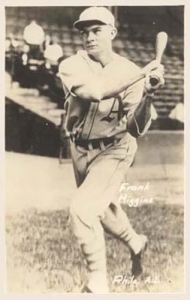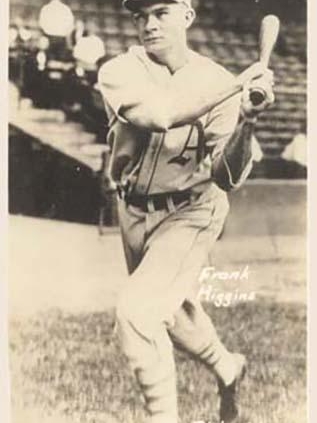June 27, 1935: Think Pinky: Higgins’ aerial assault grounds Red Sox
 One of just two Philadelphia Athletics to make the 1934 American League All-Star roster, third baseman Mike “Pinky” Higgins was the subject of gossip that offseason that he might be sold to the New York Yankees for as much as $50,000. Owner-manager Connie Mack was peppered with questions about the proposed deal in January 1935 upon returning from an Orient tour, only to reply, “There never was a deal on for Higgins that I know of.”1 The 25-year-old Higgins would not sign a contract for the coming season until February 24.2
One of just two Philadelphia Athletics to make the 1934 American League All-Star roster, third baseman Mike “Pinky” Higgins was the subject of gossip that offseason that he might be sold to the New York Yankees for as much as $50,000. Owner-manager Connie Mack was peppered with questions about the proposed deal in January 1935 upon returning from an Orient tour, only to reply, “There never was a deal on for Higgins that I know of.”1 The 25-year-old Higgins would not sign a contract for the coming season until February 24.2
The A’s optimism for 1935 was quashed when Higgins suffered a sprained ankle before the season – not during spring training in Florida, but at the Baker Bowl during the third game of the preseason City Series with the Phillies. As James S. Isaminger of the Inquirer related, “Higgins was on second when [pitcher] Fidgety Phil Collins suddenly turned around and zinged the ball to second to catch Mike off base. Higgins regained the bag, but in so doing hurt his ankle.”3 Higgins awoke the next morning with a limp and was out of the starting lineup until May 8. The Inquirer lamented, “To be deprived of the services of such a batting and fielding third-sacker as Higgins is nothing short of calamity.”4 Indeed, the A’s began the season 2-11.
Higgins entered the lineup lacking his usual power, with Mack even dropping him briefly from fifth to seventh in the batting order. Higgins was batting under .200 as late as June 15. Returning from a three-week road trip that saw Higgins homer only once, the A’s opened a homestand against the Boston Red Sox on June 27.
A’s starting pitcher Johnny Marcum began the afternoon’s offensive assault against Boston starter Wes Ferrell by leading off the third inning with his second home run of the year, to right field. “Johnny’s swat landed in 20th St.,” reported the Philadelphia Record.5 With one out in the fourth, Higgins, whom Ferrell had struck out in the second, connected for a solo home run to left. “(Higgins) punched the ball completely over the left field roof,” the Bulletin recounted. “It didn’t pause to touch wood on the way over.”6
The A’s drove Ferrell off the mound with a five-run fifth. Catcher Paul Richards led off the inning with a single to left. After a sacrifice and a fly out, Doc Cramer drove in Richards with a single to center, and Bob Johnson homered. Ferrell then walked Jimmie Foxx before Higgins hit his second home run, into the left-field deck. Red Sox player-manager Joe Cronin lifted Ferrell, who had completed his previous four starts, for Henry Johnson.
The A’s scored twice more in the sixth on singles by Wally Moses and Cramer. In the seventh, Johnson walked Foxx before surrendering Higgins’s third home run of the game, which hit off the roof of the center-field stands.
Philadelphia added three more runs in the bottom of the eighth, scoring in its sixth straight inning, giving Higgins a final turn at bat with Bob Johnson on third, Foxx on first, and none out. Game accounts in the Philadelphia newspapers mentioned the A’s fans’ excitement at Higgins’s chance to equal Lou Gehrig’s four-homer performance at Shibe Park three years earlier, but Higgins ended the afternoon as he had begun it, by striking out; adding insult to injury, after the third strike Johnson was tagged out trying to steal home.
Higgins’s three home runs equaled his output thus far in 1935, and he was the first big leaguer with a three-homer game since Babe Ruth’s swan song a month earlier with the Boston Braves. He was assisted offensively by Doc Cramer’s four hits and Bob Johnson, who went 2-for-5 with four RBIs. With such a cushion of runs, Marcum had an easy time dispatching the Red Sox, scattering four hits and four walks en route to his fifth victory of the season.
Most of the game accounts called Higgins, born Michael Franklin Higgins, by a different middle name. “Michael Francis [sic] Higgins, the willowy Texan with the sharpshooter’s eyes, jumped out of his slump in the grand manner at Shibe Park yesterday when, with Joe Louis punches, he bombed three mastodonic home runs in a row to score five of the runs that smeared the Red Sox,” Isaminger began his game account in the Inquirer.7 “Sir Michael Francis Higgins walked off with the show,” Bill Dooly of the Record wrote,8 while Al Horwits of the Evening Public Ledger dubbed Higgins “the Texas Sandow.”9
The outburst against the Red Sox marked a change in Higgins’ fortunes. From June 27 through the end of the season, he hit .331 with a .962 OPS and drove in 72 runs in the final 89 games of the year. His 23 home runs were sixth in the American League. After the AL All-Star selections were made, Isaminger at the Inquirer wondered, “Why was Frank Higgins, the beau ideal of third sackers, overlooked? Yes, he started the season in a batting slump because of injuries. So did Simmons, Gehrig, Cronin and Chapman. The difference between Higgins and the other slumpers is that Frank got over his. He is now batting hot and is playing as good ball as he ever did.”10 Henry McCormick of the Wisconsin State Journal queried, “And what happened to ‘Pinkey’ [sic] Higgins of the Athletics, almost anybody’s choice for third base?”11 Pinky was unable, however, to lift the Athletics on his back, as they went 29-52 after the All-Star break to end with a 58-91 record and their first last-place finish since 1921.
SOURCES
In addition to the sources cited in the Notes, the author accessed Retrosheet.org, Baseball-Reference.com, SABR.org, and The Sporting News archive via Paper of Record.
NOTES
1 Stan Baumgartner, “Bing Not Out in Cold, Mack Tells Scribes,” Philadelphia Inquirer, January 10, 1935: 17.
2 “Pinky Higgins Signs,” Hazleton (Pennsylvania) Standard-Sentinel, February 25, 1935: 9.
3 James C. Isaminger, “A’s Nail Phillies 16-2 as Foxx Raps Pair,” Philadelphia Inquirer, April 14, 1935: 27.
4 “Series Slants!” Philadelphia Inquirer, April 15, 1935: 17.
5 Bill Dooly, “Mackmen Bomb Boston for Five Circuit Drives; Win Opener, 14-2,” Philadelphia Record, June 28, 1935: 18.
6 Cy Peterman,”Higgins’ Three Homers Pace A’s Against Friend Ferrell,” Philadelphia Bulletin, June 28, 1935: 24.
7 Isaminger, “Macks Win, 14-2; Phils Bow, 11-1, Triumph, 8-7,” Philadelphia Inquirer, June 28, 1935: 17. On June 25 Joe Louis had defeated Primo Camera in the sixth round of a bout at Yankee Stadium.
8 Dooly.
9 Al Horwits, “Mack Will Bank on Hurling Staff,” Philadelphia Evening Public Ledger, June 28, 1935: 27-28. Eugen Sandow (1867-1925) was a well-known German bodybuilder.
10 Isaminger, “Tips from the Sports Ticker,” Philadelphia Inquirer, July 7, 1935: Sports Section, 6.
11 Henry McCormick, “No Foolin’ Now,” Wisconsin State Journal (Madison), June 30, 1935: 19.
Additional Stats
Philadelphia Athletics 14
Boston Red Sox 2
Shibe Park
Philadelphia, PA
Box Score + PBP:
Corrections? Additions?
If you can help us improve this game story, contact us.


